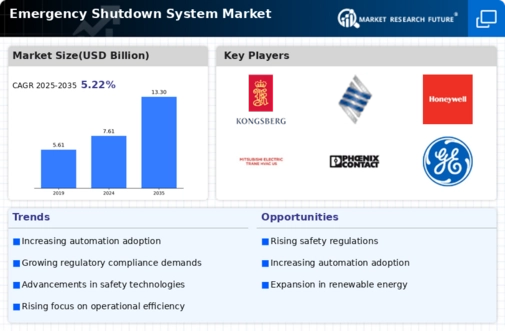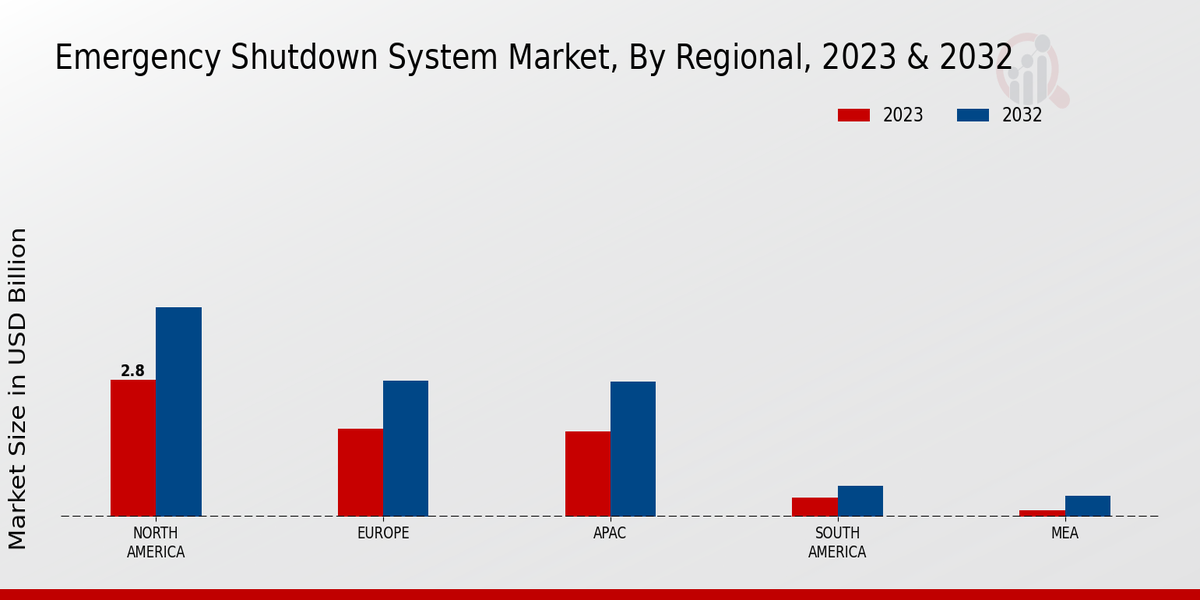Market Growth Projections
The Global Emergency Shutdown System Market Industry is poised for substantial growth, with projections indicating a market value of 7.61 USD Billion in 2024 and an anticipated increase to 13.3 USD Billion by 2035. This growth trajectory suggests a compound annual growth rate (CAGR) of 5.23% from 2025 to 2035. Such figures reflect the increasing adoption of emergency shutdown systems across various sectors, driven by regulatory compliance, technological advancements, and heightened safety awareness. The market's expansion is indicative of the critical role these systems play in ensuring operational safety and environmental protection in an evolving industrial landscape.
Rising Demand in Oil and Gas Sector
The oil and gas sector is a significant driver of the Global Emergency Shutdown System Market Industry. With the inherent risks associated with oil extraction and processing, companies are increasingly investing in robust emergency shutdown systems to safeguard personnel and assets. The sector's growth, fueled by rising energy demands, necessitates the implementation of reliable safety measures. For instance, major oil companies are adopting advanced shutdown systems to comply with international safety standards. This trend is expected to contribute to a compound annual growth rate (CAGR) of 5.23% from 2025 to 2035, reflecting the sector's commitment to enhancing safety protocols.
Expansion of Renewable Energy Projects
The expansion of renewable energy projects is emerging as a key driver for the Global Emergency Shutdown System Market Industry. As countries transition towards sustainable energy sources, the need for reliable safety systems in renewable energy installations, such as wind and solar farms, is increasing. These projects often involve complex operations that require effective emergency shutdown protocols to protect both infrastructure and personnel. The integration of emergency shutdown systems in these projects is essential for ensuring operational safety and compliance with regulatory standards. This trend is expected to bolster market growth as investments in renewable energy continue to rise globally.
Increasing Industrial Safety Regulations
The Global Emergency Shutdown System Market Industry is experiencing growth driven by stringent industrial safety regulations. Governments worldwide are implementing more rigorous safety standards to mitigate risks associated with hazardous operations. For instance, the Occupational Safety and Health Administration (OSHA) in the United States has established guidelines that necessitate the installation of emergency shutdown systems in various sectors. This regulatory push is expected to contribute to the market's expansion, as companies invest in advanced systems to comply with these mandates. As a result, the market is projected to reach 7.61 USD Billion in 2024, reflecting the increasing emphasis on safety and compliance.
Technological Advancements in Automation
Technological advancements in automation are significantly influencing the Global Emergency Shutdown System Market Industry. Innovations in sensor technology, artificial intelligence, and machine learning are enhancing the capabilities of emergency shutdown systems. These advancements allow for quicker response times and improved reliability, which are crucial in preventing catastrophic failures. For example, the integration of real-time monitoring systems enables operators to detect anomalies and initiate shutdown procedures proactively. This trend is likely to drive market growth, as industries seek to adopt cutting-edge technologies to enhance operational safety and efficiency, potentially leading to a market value of 13.3 USD Billion by 2035.
Growing Awareness of Environmental Protection
Growing awareness of environmental protection is influencing the Global Emergency Shutdown System Market Industry. As industries face increasing scrutiny regarding their environmental impact, the implementation of emergency shutdown systems is becoming a priority. These systems play a crucial role in preventing environmental disasters by ensuring that hazardous materials are contained during emergencies. Regulatory bodies are advocating for the adoption of such systems to mitigate potential environmental harm. This heightened awareness is likely to drive market growth, as companies recognize the importance of safeguarding both human life and the environment, thereby enhancing their corporate responsibility initiatives.





















